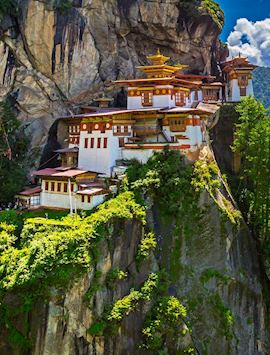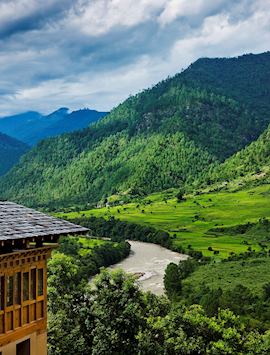Overlooking a valley from its cliffside perch, Tiger’s Nest Monastery rewards a visit with both panoramic views and a look at some of Bhutan’s most important Buddhist history. However, the temple is only reachable after a steep, two-hour hike. Here, we answer your most frequently asked questions about visiting Tiger’s Nest.
What is the history and significance of Tiger’s Nest Monastery?
The most sacred Buddhist site in Bhutan, the mountainside location is said to be where Padmasambhava (an 8th-century Indian guru) meditated when he brought Buddhism to Bhutan. Called “the Second Buddha” by his followers, Padmasambhava is said to have arrived on a flying tiger to quell demons in Bhutan.
Centuries later, Padmasambhava is thought to have returned to the same site, reincarnated as Tenzin Rabgye, the fourth Druk Desi (ruler of Bhutan). The Druk Desi commissioned the current temple that we know and visit today.
Where is Tiger’s Nest Monastery located?
Clinging to a cliff overlooking the Paro Valley, the monastery is about a two-hour (albeit fairly circuitous) drive from the capital of Thimphu. From the parking area, it’s about a two-hour hike up to the temple itself.

What is the hike like to Tiger’s Nest Monastery? How long and hard is it?
To reach the monastery, you’ll need to undertake a steep but well-trodden path that clocks in at about 6.5 km (4 miles) round trip. Along the way, you’ll gain about 550 m (1,800 ft) in elevation. The whole trip, including a two-hour tour inside the monastery, usually takes about six hours.
The hike itself begins at the parking area (itself located at about 2,597 m (8,520 ft) above sea level), where your guide will lead you up the well-maintained trail through green woodland, passing occasional prayer wheels as you go. This is a very manageable section of the hike.
About half-way up, you’ll reach a cafe where you can pause for a rest and a snack, perhaps cake or hot soup if it’s chilly. Some visitors finish their hikes here, relaxing and enjoying the views, while other members of the party continue onward.
The real climb begins after the cafe. A steeper trail cuts through more trees, with occasional clearings to allow sweeping views over the valleys. The path zigzags, following the cliff’s contours, and it can get very steep here, though there are stairs built into the mountain face to help you cover the steepest sections.
The very last stretch is mostly flat and paved, with small sections of stairs up and down. With the mountain face to one side and plunging terrain to the other, you’ll have exceptional views of the monastery itself as well as the mountainous terrain.
This is one of the most popular trails in the whole country and you will encounter plenty of other hikers along the way. We suggest an early start to avoid the worst of the crowds.
How do I get to the trailhead?
We’ll arrange for a driver to pick you up, along with your guide, and drive you to the trailhead.
Do I need a guide to hike to Tiger’s Nest?
You don’t need one to make the hike — there's no chance of getting lost. However, once you’ve reached the top, a guide can lead you through the monastery itself. They’ll provide insights into how the building embodies Bhutan’s history, spirituality, and art.

What should I pack for a hike to Tiger’s Nest Monastery?
You should carry a daypack with the usual equipment for a day hike, including water, sunscreen, a hat, snacks, etc. Your guide will carry extra water. You can also bring a packed lunch to eat once you reach the temple.
Additionally, hiking poles can be useful, especially on the way back down.
What’s the etiquette when visiting Tiger’s Nest Monastery?
Upon arrival, you’ll store your shoes, mobile phone, camera, backpack, and hat in a locker. Please also wear modest clothing that covers your knees and shoulders. Inside, behave as you would at any place of worship.
When is Tiger’s Nest Monastery open to visitors?
The monastery is open year-round.
When is the best time to visit Tiger’s Nest Monastery?
From October to December, you’ll find sunny skies and comfortable temperatures, ideal for hiking. Autumn mists often cling to the monastery during these months, which can add an atmospheric note but also might obstruct your views. This is also a popular time to visit Bhutan — black-necked cranes arrive in Phobjikha Valley in early November— so you’ll need to plan well in advance.
You’ll also find comfortable temperatures in March, April, and early May, when the rhododendron blooms flood the valleys with shades of pinks and purples.
Read more about trips to Bhutan
Start thinking about your experience. These itineraries are simply suggestions for how you could enjoy some of the same experiences as our specialists. They're just for inspiration, because your trip will be created around your particular tastes.
View All Tours in Bhutan



